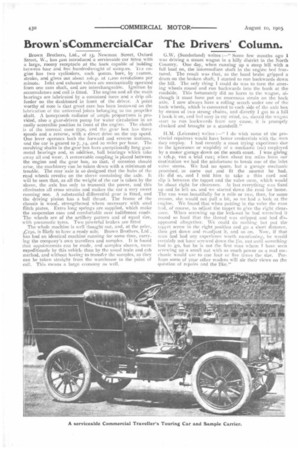Brown' sCommercialCar The Drivers' Column.
Page 16

If you've noticed an error in this article please click here to report it so we can fix it.
Brown Brothers, Ltd., of es, Newman Street, Oxford Street, W., has just introduced a serviceable car htted with a large, roomy receptacle at the back capable of holding between four and five hundredweight of sanip.ee. Tee engine has two cyclinders, each omm. bore, by inorrine stroke, and gives out about tolep. at 1,200 revolutions per minute. Inlet arid exhaust valves are mechanically operated from one cam shaft, and are interchangeable. Ignition by accumulators and coil is fitted_ The engine and all the main bearings are lubricated by a combined force and a drip oilfeeder on the dashboard in front of the driver. A point worthy of note is that great care has been bestowed on the lubrication of the universal joints belonging to the propeller shaft. A honeycomb radiator of ample proportions is provided, also a gear-driven pump for water circulation in an easily accessible position in front of the engine. The clutch is of the internal cone type, and the gear box has thme speeds and a reverse, with a direct drive on the top speed. One lever operates both the forward and reverse motions, and the car is geared to 7, n4, and 20 nnies per hour. The revolving shafts in the gear box have exceptionally long gunmetal bearings and, in addition, ball bearings which Lake away all end wear. A remoyeabie coupling is placed between the engine and the gear box, so that, if occasion should arise, the machinery can be taken down with a minimum of trouble. The rear axle is so designed that the hubs of the road wheels revolve on the sleeve containing the axle. IL will be seen that, as all the weight of the car is taken by the sleeve, the axle has only to transmit the power, and this eliminates all Cl"Oss strains and makes the car a very sweet running one. A substantial differential gear is fitted, and the driving pinion has a ball thrust. The frame of the chassis is wood, strengthened where necessary with steel flitch plates. Extra long springs are supplied, which make the suspension easy and comfortable over indifferent roads. The wheels are of the artillery pattern and of equal size, with pneumatic tyres. Two powerful brakes are fitted The whole machine is well thought out, and, at the price, 4'250, is likely to have a re..adv saleBrown Brothers, Ltd., has had an identical machine running for some time, carrying the company's own travellers and samples. It is found that appointments can be made, and samples shown, more expeditiously by this vehicle than by the usual train and cab method, and without haying to transfer the samples, as they can be taken straight from the warehouse to the point of call. This means a large economy as well. G.W. (Sunderland) writes :—" Some few months ago I was driving a steam wagon in a hilly district in the North Country. One day, when running up a steep hill with a full load on, the intermediate shaft in the engine bed fractured. The result was that, as the band brake gripped a drum on the broken shaft, I started to run backwards down the hill. The only thing I could do was to turn the steering wheels round and run backwards into the bank at the roadside. This fortunately did no harm to the wagon, although it must have put an enormous strain on the back axle. I now always have a rolling scotch under one of the back wheels, which is connected to each side of the axle box by means of two strong chains, and directly I get to a hill I hook it on, and feel easy in my mind, as, should the wagon iitrt to run backwards from any cause, it is promptly checked and brought to a standstill."
H.M. (Leicester) writes.—" I do wish sonic of the provincial repairers would have better credentials with the men they employ. I had recently a most trying experience due to the ignorance or stupidity of a mechanic (sic) employed by a motor garage down on the south coast. I was giving a teh.p. van a trial run; when about ten miles from our destination we had the misfortune to break one of the inlet valve stems. We had no spare, but a garage mechanic promised. to come out and fit the nearest he had. I le did so, and I told him to take a thin card and slip it between the tappet and the valve stem, which would be about right for clearance. At last everything was fixed up and he left us, and we started down the road for home. The van went beautifully for a mile or two, then, for some reason, she would not pull a bit, so we had a look at the engine. We found that when putting in the valve the man had, of course, to adjust the tappet to give the right clearance. When screwing up the lock-nut he had wrenched it round so hard that the thread was stripped and had disappeared altogether. We could do nothing but put the tapvet screw in the right position and go a short distance, then get down and re-adjust it, and so on. Now, if that man had had any experience worth mentioning, he would certainly not have screwed down the elin. nut until something had to go, but he is not the first man whom I have seen srrewing up a small nut with is much power as a real mechanic would use to one fou)or five times the size. Per
sonic of your other readers will air their views on the question of repairs and the like."




















